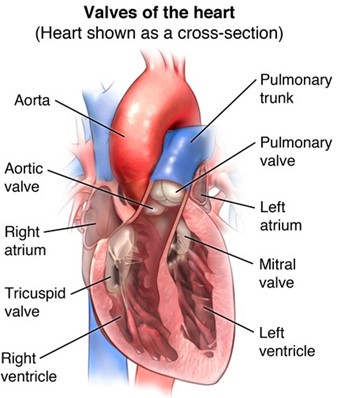Which of the following heart valves lies between the left atrium and left ventricle and prevents the regurgitation of blood from the ventricle back into the atrium?
Mitral valve.
Tricuspid valve.
Pulmonary valve.
Aortic valve.
The Correct Answer is A
The mitral valve lies between the left atrium and left ventricle and prevents the regurgitation of blood from the ventricle back into the atrium.

It has two leaflets that open and close to allow blood to flow from the lungs into the left atrium and then to the left ventricle.
Choice B is wrong because the tricuspid valve lies between the right atrium and right ventricle and prevents the regurgitation of blood from the ventricle back into the atrium.
It has three leaflets that open and close to allow blood to flow from the body into the right atrium and then to the right ventricle.
Choice C is wrong because the pulmonary valve lies between the right ventricle and the pulmonary artery and prevents the regurgitation of blood from the artery back into the ventricle.
It has three leaflets that open and close to allow blood to flow from the right ventricle to the lungs, where it picks up oxygen.
Choice D is wrong because the aortic valve lies between the left ventricle and the aorta and prevents the regurgitation of blood from the aorta back into the ventricle.
It has three leaflets that open and close to allow blood to flow from the left ventricle to the rest of the body.
Nursing Test Bank
Naxlex Comprehensive Predictor Exams
Related Questions
Correct Answer is B
Explanation
As a result of the allergen-antibody reaction, mast cells release histamine.
This is because when mast cells are exposed to an allergen that binds to IgE antibodies attached to their FcɛRI receptors, they release histamine and other inflammatory mediators.
Histamine causes vasodilation, increased capillary permeability, mucus secretion, and smooth muscle contraction, which result in allergic symptoms such as itching, swelling, sneezing, and wheezing.
Mast cells do release histamine in response to allergen-antibody reactions. Some additional sentences are:
Normal ranges of histamine levels vary depending on the tissue and the method of measurement, but they are usually low in healthy individuals and elevated in allergic conditions.
Histamine can be degraded by enzymes such as diamine oxidase and histamine N- methyltransferase, or inhibited by drugs such as antihistamines.
Correct Answer is C
Explanation
This is because it is an example of a positive feedback loop, which amplifies the change and moves the system away from its normal state.
A negative feedback loop is a mechanism that reverses a deviation from the set point and maintains homeostasis.
Choice A is wrong because increasing heart rate and force of contraction when blood pressure falls is a negative feedback loop that restores blood pressure to normal.
Choice B is wrong because secreting insulin after a meal to return blood sugar concentration toward normal is a negative feedback loop that regulates glucose levels.
Choice D is wrong because shivering when body temperature falls below normal is a negative feedback loop that increases heat production and raises body temperature.
Normal ranges for blood pressure are 90/60 mmHg to 120/80 mmHg, for blood glucose, are 70 mg/dL to 140 mg/dL, and for body temperature are 36.5°C to 37.5°C or 97.7°F to 99.5°F.
Whether you are a student looking to ace your exams or a practicing nurse seeking to enhance your expertise , our nursing education contents will empower you with the confidence and competence to make a difference in the lives of patients and become a respected leader in the healthcare field.
Visit Naxlex, invest in your future and unlock endless possibilities with our unparalleled nursing education contents today
Report Wrong Answer on the Current Question
Do you disagree with the answer? If yes, what is your expected answer? Explain.
Kindly be descriptive with the issue you are facing.
